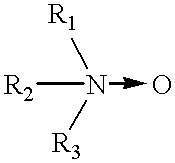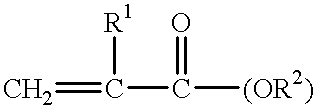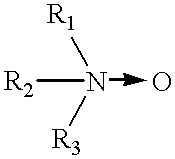Binder composition and process
a technology of binding composition and process, applied in the direction of layered products, etc., can solve the problems of short glass fibers as strands or bundles, poor dispersion of glass fibers, and large clumps of glass fibers,
- Summary
- Abstract
- Description
- Claims
- Application Information
AI Technical Summary
Benefits of technology
Problems solved by technology
Method used
Image
Examples
example 2
Urea Formaldehyde Resin Modified by Various Amine Oxides
A commercial UF resin sold by Borden Chemical, Inc. under the trade name FG 458 was used in this example. Amine oxides with different chemical structures were added to the UF resin to make up different modified UF resin solutions which were applied to glass fiber mats, cured and tested for the properties shown in Table 2 below. In Table 2, the various compositions tested were the following:
Resin 1 was the resin (FG 458) without the addition of amine oxide.
Resins 2-5 were that of the resin (FG 458) modified by the following indicated amine oxides:
Resin 2 contained N-coco alkyl 2,2'-imiobis-ethanol-N-oxide which was added to FG 458 such as that the resulting 60% solids solution had 912 ppm of the amine oxide.
Resin 3 contained coco alkylethylamine oxide which was added to FG 458 such that the resulting 60% solids solution had 912 ppm of the amine oxide.
Resin 4 contained coco alkyldimethylamine oxide. This oxide was added to FG 458...
example 3
Binder of UF Resin Modified with Latex Compared with Binder of UF Resin Containing Both Amine Oxide and Latex
This example demonstrates the advantage of this invention wherein the UF resin has been modified with both an amine oxide and a vinyl acrylate latex (Binder 3B) as compared to a UF resin which was modified with a commercial binder but which was not further modified by addition of the amine oxide (Binder 3A) in Table 3 below. The UF resin used in this example was Resin FG 413 which is produced by Borden Chemical, Inc. The amine oxide used in Binder 3B was dimethylhexadecylamine oxide. The vinyl acrylate latex in Binder 3B had a glass transition temperature of about 100.degree. C. The handsheets and application of binder were performed in a manner similar to that of Example 1 above. The latex to UF resin ratio in Binder 3B was 10 parts of latex to ninety parts of UF resin on a dry weight basis. Conditions of the tests and results of this example wherein the two different binder...
example 4
UF Resin Binder Composition Using Both an Amine Oxide and a Water Soluble Polymer
This example compares (a) a binder of this invention wherein the urea formaldehyde resin is modified by both an amine oxide and an ammonia neutralized water soluble polymer of this invention, designated as Binder 4B in Table 4 below, with (b) a binder having the urea formaldehyde resin modified by the same ammonia neutralized water soluble polymer as was used in Binder 4B but without amine oxide, designated as Binder 4A below in Table 4. The UF resin in Binder 4A and Binder 4B was that of Resin FG 413 which is supplied by Borden Chemical, Inc. The column in Table 4 entitled "Wt / Dt %" is simply the wet tensile reading divided by the dry tensile reading.
It can be seen from the above Table 4 that the binder of this invention, wherein the UF resin was modified with both an amine oxide and the water soluble polymer (Binder B), provided a substantial increase in the tear property of the mat without any loss o...
PUM
| Property | Measurement | Unit |
|---|---|---|
| glass transition temperature | aaaaa | aaaaa |
| glass transition temperature | aaaaa | aaaaa |
| diameters | aaaaa | aaaaa |
Abstract
Description
Claims
Application Information
 Login to View More
Login to View More - R&D
- Intellectual Property
- Life Sciences
- Materials
- Tech Scout
- Unparalleled Data Quality
- Higher Quality Content
- 60% Fewer Hallucinations
Browse by: Latest US Patents, China's latest patents, Technical Efficacy Thesaurus, Application Domain, Technology Topic, Popular Technical Reports.
© 2025 PatSnap. All rights reserved.Legal|Privacy policy|Modern Slavery Act Transparency Statement|Sitemap|About US| Contact US: help@patsnap.com



